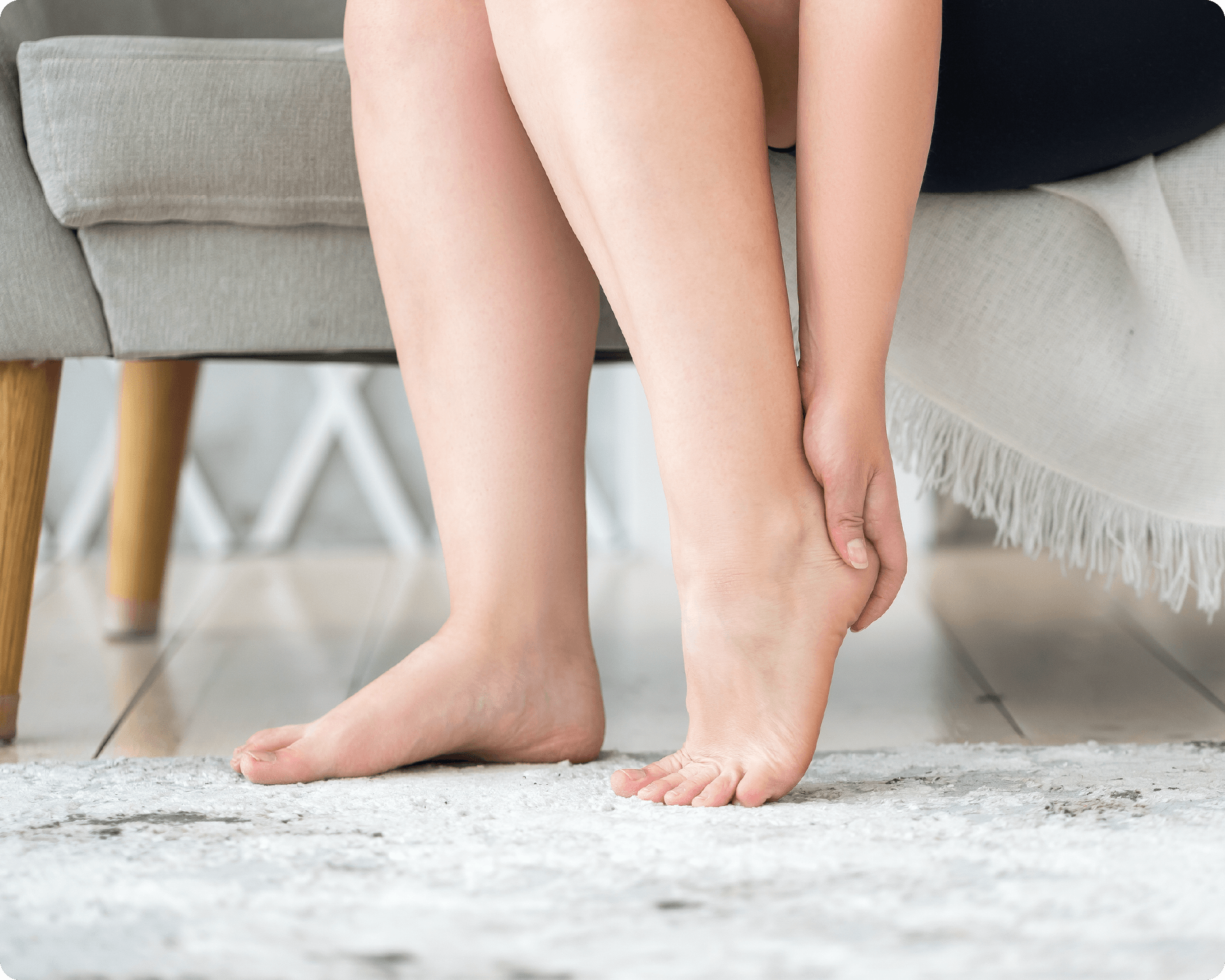While hormone replacement therapy (HRT) is safe and highly effective for treating menopause symptoms, it isn’t the best fit or the first preference for everyone.
Some women look for alternative medicines for menopause symptoms that aren't hormone-based, while others seek holistic therapies that encompass their physical, emotional and spiritual well-being.
Reflexology is one such practice that has helped many menopausal women better navigate this transitional life stage and manage their symptoms.
What is reflexology?
Reflexology is a non-invasive complementary therapy that can support your journey through perimenopause and menopause. It has been practised for thousands of years and works similarly to acupuncture or acupressure. Reflexology is based on the theory specific points on the feet, hands or ears correspond to other parts of the body, and that by applying gentle pressure to these points, a flow of energy can be sent to areas in the body, sending calming messages and promoting healing. For example:
- On the front of the foot, the web between the toes corresponds to the lymphatic system.
- The reflex to the heart is situated on the sole of the left foot.
- This thyroid reflex is situated on both feet at the base of the big toe, down around the ball and into the groove below the bone.
- On both feet, the side of the foot below the inner anklebone on the heel line corresponds to the bladder.
- The outer ankle is where the reflex for the ovaries is located, while reflexes for the uterus and vagina are found on the inner ankle.
- The toes are largely connected to the head and neck area, with the brain reflex located on the pads of the big toes.
Reflexology is generally considered to be a very relaxing experience, which may also help improve mood, release tension, aid sleep, and promote a sense of well-being. You may feel some other changes too, which vary from person to person.
What happens during a reflexology session?
In your very first session, you can expect your reflexologist to start with a brief health consultation to understand your medical history, any concerns you have, and the symptoms you want help with.
Reflexology sessions typically last 30-60 minutes and are usually conducted in a calm, quiet space with soft lighting and soothing music to promote relaxation. You’ll sit in a reclining chair or lie on a massage table throughout.
During a foot reflexology treatment, you are required to remove your socks and shoes and are encouraged to relax whilst your reflexologist uses specific massage techniques to work these points on your feet and lower legs. They may include thumb-walking, finger pressure, or gentle kneading.
You might feel tenderness in some areas, which can indicate an imbalance in the corresponding body part. The reflexologist may focus more on these areas. Once they have finished, the reflexologist might discuss any findings or areas of tension they noticed.
The benefits of reflexology for menopause
Reflexology, in some women, seems to be highly effective in helping with both physical and emotional menopause symptoms without the side effects associated with hormone-based treatments.Studies have been conducted on how reflexology impacts some of the most common menopause symptoms, seeming to indicate that this holistic therapy results in improvements. It may be used alone or alongside HRT which is considered first line in the majority of women. Reflexology is unlikely to have additional positive bone or cardiovascular impacts but may be an excellent adjunct therapy.
Hot flushes
Hot flushes are a very common vasomotor symptom (VMS) of menopause, affecting up to 80% of women. They are caused by fluctuating hormone levels as when oestrogen declines, your body can become more sensitive to changes in body temperature.
Hot flushes come on suddenly and bring with them an intense feeling of warmth across the face and upper body followed by flushing, perspiration and sometimes chills once they are over.
Reflexology may help regulate the autonomic nervous system and improve circulation, potentially reducing the frequency and severity of vasomotor symptoms like hot flushes.
Night sweats
Around three-quarters of women experience night sweats in menopause. They are a common VMS that occurs as a result of declining oestrogen and can lead you to wake up in the night to find your body, night clothes and bed soaked in sweat.
A 2016 study found that women who received reflexology treatments twice a week for six weeks reported fewer night sweats.
Sleep disturbances
Many women report sleep problems during menopause such as waking up during the night, difficulty falling asleep, and not getting enough sleep.
Reflexology's relaxation effects may improve sleep quality by reducing stress and promoting balance in the nervous system. By targeting specific reflex points associated with sleep regulation, this therapy can help individuals achieve more restorative sleep.
A systemic review and meta-analysis of 42 articles concluded that foot reflexology led to significant improvements in sleep disturbances while more specific studies have been conducted that indicate reflexology can help improve sleep quality in menopausal and postmenopausal women, increasing average daily sleep duration and reducing fatigue.
Stress and anxiety
The hormonal changes that arise during menopause can impact your mental health as well as your physical health. It’s not unusual for women to not feel like themselves. In addition, many women in midlife are juggling other stressors such as a full-time job or caring responsibilities while they navigate menopause.
As a result, up to 50% of perimenopausal and postmenopausal women experience psychological and emotional symptoms including anxiety, depression and stress.
Reflexology has shown promise in reducing anxiety and stress by calming the body and stimulating endorphin release. Its ability to lower cortisol levels and promote relaxation makes it beneficial for menopausal women experiencing heightened stress and anxiety.
Low mood
62% of women between 50 and 64 report that the menopause has affected their mood.
Reflexology may help balance mood by stimulating reflex points linked to hormonal regulation and emotional well-being and promoting the release of endorphins. Some research indicates improvements in depression and emotional health after consistent reflexology sessions.
Aches and pains
Hormonal changes during menopause can impact areas across the entire body, with aches and pains in the muscles and joints being a common symptom. This is because:
- Oestrogen helps to nourish the tissues of the body and keep them youthful and elastic. It also reduces the body's inflammation levels and regulates new bone growth.
- Progesterone increases feelings of natural calmness, boosts mood and increases pain threshold levels.
- Testosterone supports and increases bone density and helps transform fat into muscle.
When these hormones decline, inflammation can increase, skin becomes drier, less elastic and more fragile, bone density reduces, and your pain tolerance can diminish. This can lead to aches and pains becoming more prominent.
Foot reflexology triggers the release of endorphins and enkephalins which can not only improve mental energy but can also help relieve pain.
Sexual function
Reflexology may support better hormonal balance, potentially helping to support libido and sexual function issues during menopause. By enhancing blood flow and relaxation, it can also ease tension and discomfort that may affect intimacy.
Overall well-being
Reflexology has been shown to improve overall well-being and quality of life but it’s about much more than just the connection between the feet and other areas of the body. In addition to the massage itself, the act of setting aside a regular time to relax, focus on yourself, and feel listened to, brings its own benefits, particularly during periods of heightened stress resulting from the constant demands on your time, your responsibilities, and changing hormone levels.
At Menopause Care, we are here to help you explore your options for managing menopause symptoms. We can provide you with evidence-based advice on HRT, herbal alternatives and complementary therapies, empowering you to make the right choices for your own health and well-being. To get started, book a consultation with a menopause doctor.





